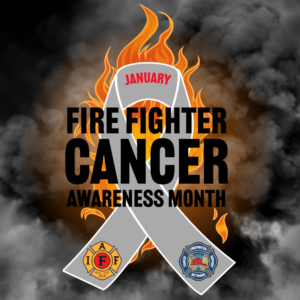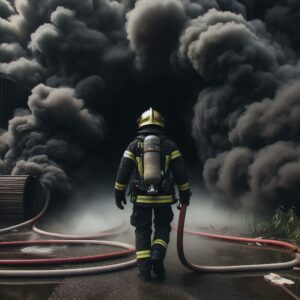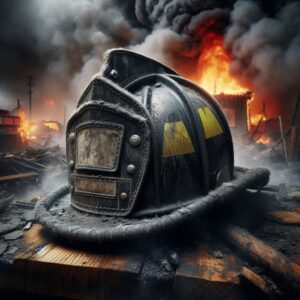January 2024 marks the first annual Fire Fighter Cancer Awareness Month, an initiative to raise awareness and provide education on the risks of occupational cancer among firefighters. This first recognition in Canada follows the example of the International Association of Fire Fighters (IAFF) and the Firefighter Cancer Support Network (FCSN) in the United States. The purpose of this month is to highlight the dangers posed by toxic substances that firefighters encounter in the course of their jobs, and to provide the tools and protocols for illness prevention and early detection.
Firefighters face a higher risk of cancer diagnosis and mortality compared to the general population, and cancer accounts for more than 86% of all duty-related deaths among Canadian firefighters. The Government of Canada has implemented various measures to tackle this issue, such as the 2021 Firefighters Action Plan and the development of a national framework to improve access to cancer prevention and treatment for firefighters. Fire Fighter Cancer Awareness Month also aims to support those with a cancer diagnosis within their departments and to honour the fallen firefighters who lost their lives to occupational cancer.
It is a common misconception that because fire fighters wear breathing apparatus and special suits, they are fully protected from the outside environment and the increasing number of incredibly harmful contaminants and cancer causing particulates it contains at a fire scene. This could not be any further from the truth.
During a fire, various materials burn and release a mixture of toxic combustion products, including gases, particulates and carcinogenic compounds. The typical structure fire today involves the high-temperature destruction of many types of plastics, foams, various species of wood, fabrics, and other materials. These burning materials often liberate gases and particulates that contain toxic, reactive, and otherwise unhealthy chemicals that pose inhalation and skin absorption hazards. These particulates and chemicals stick to and contaminate all of the gear a fire fighter is wearing, including their regular clothing within the bunker gear.
The visible particles of combustion that we see as smoke are the unburned remnants of these dangerous particulates and chemicals. Smoke contains several toxic substances and carcinogens that firefighters need to protect against. Some of the harmful substances found in fire smoke include Acrolein, Carbon Monoxide (CO), Formaldehyde, and Glutaraldehyde. These substances can cause intense irritation to the eye and mucous membranes of the respiratory tract, decrease the oxygen transport of the blood, and have carcinogenic effects.
Due to repetitive exposure to these dangerous contaminants, decontamination is crucial for fire fighters and one of the best ways to decrease the risk of developing job-related cancers. Here’s a brief summary of why deconning both at scene and afterwards is crucial:
Contaminated Personal Protective Equipment (PPE): Previously, a dirty, contaminated helmet was considered a trophy. However, the culture surrounding contaminated PPE has changed. The time immediately after firefighting has been identified as the most crucial for decontamination.

“Shower within the Hour”: The first hour after loss stop is now considered an opportunity to help prevent firefighter cancer. “Shower within the hour” is considered a best practice to reduce exposure to the products of unburned combustion.
Training and Education: It’s crucial for the fire service and its members to educate about safe work practices. Training should emphasize the proper use and care of PPE and turnout gear.
Cancer Risk: Firefighting is linked to an increased risk of cancer. The Centers for Disease Control (CDC) identified firefighting as an inherently dangerous occupation, with cancer now becoming the leading cause of death among firefighters. Firefighters face a nine per cent increase in cancer diagnoses, and a 14 per cent increase in cancer-related deaths, compared to the general population.
Adoption of Decon: As fire officers, it’s important to discipline ourselves to automatically activate on-scene decontamination.
There are many ways you can support Fire Fighter Cancer Awareness Month and help raise awareness and education on the risks of occupational cancer among firefighters. Here are some suggestions:
- Visit the Fire Fighter Cancer Awareness Month website to access resources, training briefs, podcasts, survivor stories, and more. You can also follow @iaffofficial on social media platforms to get the latest updates and information.
- Participate in a weekly safety stand down in your department or community to discuss the scope of the cancer problem, prevention best practices, leadership tactics, and skills to help cancer survivors and departments reduce their risk of occupational cancer.
- Show your appreciation and solidarity with firefighters who are fighting cancer or have lost their lives to occupational cancer. You can send a card, a gift, or a donation to your local fire department or a firefighter support organization. You can also wear a ribbon, a pin, or a shirt with the Fire Fighter Cancer Awareness Month logo or colors (black and gold).
- Contact your local, provincial, or federal representatives and urge them to support legislation that protects firefighters from hazardous chemical exposures and provides them with access to cancer prevention and treatment. You can also sign petitions, join campaigns, or attend rallies that advocate for firefighter health and safety.
- Educate yourself and others on the dangers of toxic substances that firefighters encounter and the ways to minimize exposure and mitigate risk factors. You can also adopt a healthy lifestyle that includes regular physical activity, a balanced diet, and avoiding tobacco and alcohol.
Fire Fighter Cancer Awareness Month takes place in January, but the resources and information are available throughout the year on the websites of the IAFF, FCSN, and Health Canada.


